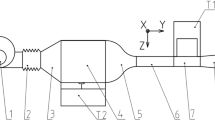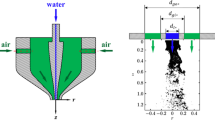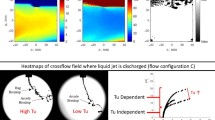Abstract
Breakup and spray formation of swirl liquid jets introduced into a low-speed cross-flow are experimentally investigated. Effects of the cross-flows on the macro and microscopic spray parameters are optically measured in terms of jet Weber number and liquid-to-gas momentum ratio. At lower jet Weber numbers, the liquid stream undergoes Rayleigh jet breakup. At higher momentum ratios, bag breakup occurs and tends to distort the liquid column into a loop-like structure. As the jet Weber number rises, stronger aerodynamic interaction and secondary flows cause multi-mode breakup. Regardless of the momentum ratio, the spray profile is hardly altered at higher jet Weber numbers. The cross-flow promotes the jet breakup and renders a finer spray in an entire range of injection velocities.
Similar content being viewed by others
References
K. A. Sallam and H. M. Metwally et al., Deformation and surface waves properties of round non-turbulent liquid jets in gaseous cross-flow, ASME Fluid Engineering Summer Con ference, ASME Paper No. FEDSM2005-77469, Huston, TX, America, (2005) 19–23.
S. J. Beresh and J. F. Henfling et al., Penetration of a transverse supersonic jet into a subsonic compressible cross-flow, AIAA Journal, 43(2) (2005) 379–389.
K. A. Sallam and C. L. Aalburg et al., Breakup of round non-turbulent liquid jets in gaseous cross-flows, AIAA Journal, 42(12) (2004) 2529–2540.
M. Y. Leong and V. G. McDonell et al., Effect of ambient pressure on an air-blast spray injected into a cross-flow, J. Propul. Power, 17(5) (2001) 1076–1084.
R. P. Fuller and P. K. Wu et al., Effects of injection angle on atomization of liquid jets in transverse airflow, AIAA Journal, 38(1) (2000) 64–72.
P. K. Wu and K. A. Kirkendall et al., Spray structures of liquid jets atomized in subsonic cross-flows, J. Propul. Power, 14(2) (1998) 173–182.
P. K. Wu and K. A. Kirkendall et al., Spray trajectories of liquid fuel jets in subsonic cross-flows, 7th international Conference on Liquid Atomization and Spray Systems, Seoul, Korea, (1997).
S. C. Li and K. Gebert, Spray characterization of high pressure gasoline fuel injectors with swirl and non-swirl nozzles, California University, San Diego, America (1998) SAE Technical Paper series.
Z. Dai and G. M. Faeth et al., Temporal properties of secondary drop breakup in the multimode breakup regime, Int. J. Multiphase Flow, 24(6) (1998) 889–912.
G. I. Taylor, The boundary layer in the converging nozzle of a swirl atomizer, Q. J. Mech. Appl. Math., 3(2) (1950) 129–139.
N. K. Rizk and A. H. Lefebvre, Internal flow characteristics of simplex swirl atomizer, J. Propul. Power, 1(3) (1985) 193–199.
N. K. Rizk and A. H. Lefebvre, Prediction of velocity coefficient and spray cone angle for simplex swirl atomizer, Proc. of International Conference on Liquid Atomization and Spray Systems, (1985).
D. J. Kim and J. H. Im et al., Effects of ambient gas density on spray characteristics of swirling liquid sheets, J. Propul. Power, 23(3) (2007) 603–611.
D. J. Kim and P. G. Han et al, Effect of flow condition and geometry on flow characteristics of a swirl injector, ILASS Americas, 16th Annual Conference on Liquid Atomization and Spray Systems, Monterey, CA (2003).
I-ping Chung and C. Presser, Fluid property effects on sheet disintegration of a simplex pressure swirl atomizer, J. Propul. Power, 17(1) (2001) 212–216.
J. L. Santolaya and L. A. Aisa et al., Experimental study of near-field flow structure in hollow cone pressure swirl spray, J. Propul. Power, 23(2) (2007) 382–389.
I. G. Bowen and G. P. Davies, “Report ICT 28,” Shell Research Ltd., London, UK, (1951).
D. P. Schmidt, Idr. Nouar, P. K. Senecal, C. J. Rutland, J. K. Martin and R. D. Reitz, Pressure-swirl atomization in the near field, SAE Technical Paper Series, 1999-01-0496.
P. K. Senecal, D. P. Schmidt, I. Nouar, C. J. Rutland, R.D Reitz and M. L. Corradini, Modeling high-speed viscous liquid sheet atomization, Int. J. of Multiphase Flow, 25 (1999) 1073–1097.
A. H. Lefebvre, Atomization and sprays, Second Ed. Hemisphere, Philadelphia, USA, (1989) 30.
A. H. Lefebvre, Atomization and sprays, Second Ed. Hemisphere, Philadelphia, USA, (1989) 112–116.
R. P. Fraser and P. Eisenklam, Research into the performance of atomizers for liquids, Imperial College of Chemical Engineering and Society, 7 (1953) 52–68.
M. S. M. R. El-Shanawany and A. H. Lefebvre, Airblast atomization: the effect of linear scale on mean drop size, J. Energy, 4(4) (1980) 184–189.
R. D. Reitz, Atomization and other breakup regimes of a liquid jet, Ph. D. Thesis, Princeton University, NJ, (1978).
J. L. York and H. F. Stubbs et al., The mechanism of disintegration of liquid sheets, Trans. ASME, 75 (1953) 1279–1286.
S. S. Lee, W. H. Kim and W. S. Yoon, Formation of Impinging Spray in Low Speed Cross Flow, J. Mech. Sci. Technol., 23(6) (2009) 1680–1692.
D. R. Gulidenbecher, C. Lopez-Rivera and P. E. Sojka, Secondary atomization, J. Exp. Fluids, 46(3) (2009) 371–402.
Author information
Authors and Affiliations
Corresponding author
Additional information
This paper was recommended for publication in revised form by Associate Editor Gihun Son
Woong-Sup Yoon is a Professor in the School of Mechanical Engineering at Yonsei University. His current research interests are in wave instabilities, unusual spray formation, emission control, and propulsion system modeling. He received a BS degree from the Department of Mechanical Engineering, Yonsei University, in 1985; an MS degree from the Department of Mechanical Engineering, University of Missouri-Rolla, in 1989; and a Ph.D degree from the Department of Mechanical and Aerospace Engineering, the Unversity of Alabama in Huntsville, in 1992.
Sang-seung Lee received his B.S. degree in Weapons Engineering from Korea Military Academy, Korea, in 2002. He then received his M.S. degrees from Yonsei University, in 2006. Mr. Lee is currently a Lecturer at the School of Weapons Engineering at Korea Military Academy in Seoul, Korea. He serves as an Editor of the Journal of Mechanical Science and Technology. Mr. Lee’s research interests include Ramjet, Atomization of injector.
Won-ho Kim received his B.S. degree in Mechanical Engineering from Yonsei University, Korea, in 2003. Mr. Kim has then gone on to do graduate work at the Ph.D in the School of Mechanical Engineering at Yonsei University in Seoul, Korea. Mr. Kim’s research interests include Atomization of 2phase flow and Dust collection efficiency.
Rights and permissions
About this article
Cite this article
Lee, S., Kim, W. & Yoon, W. Spray formation by a swirl spray jet in low speed cross-flow. J Mech Sci Technol 24, 559–568 (2010). https://doi.org/10.1007/s12206-009-1222-6
Received:
Revised:
Accepted:
Published:
Issue Date:
DOI: https://doi.org/10.1007/s12206-009-1222-6




